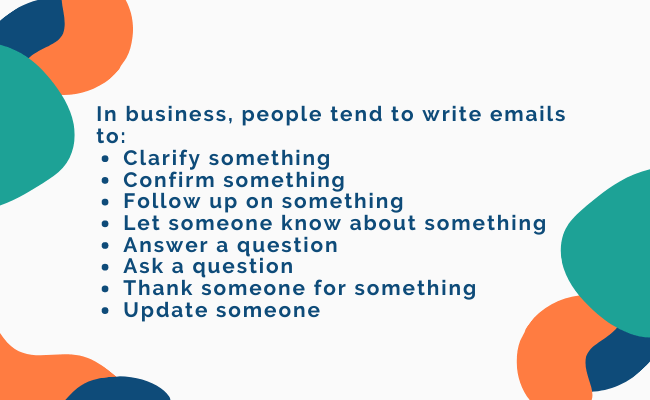If you work in any type of business environment, there is a good chance that you have to write emails on a regular basis. We're pretty sure you've also been required to write emails in English. On average, an office worker receives over 80 emails in one day. That is a lot!
However, many aren’t familiar or comfortable with the formality of business emails. In this article, we will look at useful vocabulary and expressions for writing emails in English. These are phrases that you can use in professional emails, between you and your colleagues or between you and another company. By integrating these into your emails, you will write better emails and improve your overall communication.
A typical business email has 4 parts: the header, the greeting, the email body, and the ending. Let’s go over these parts along with useful vocabulary for each.
The Header
First of all, let's talk about the email header. The email’s header contains information concerning the sender and the recipients. Generally, headers contain the following information:
1. Subject.
This is a very brief description of the topic of the message and displays in most email systems that list email messages individually. A subject line could be something like: “April financial report” or, if your spam filtering is too lenient, “Doctors don’t want you to know this secret to lose weight!!!”. Remember that the Subject line in emails is usually the first content that recipients see so it is best to write strong and clear subject lines.
2. CC (courtesy copy/ carbon copy)
This is for the email addresses of other people who need to see the information in your email. We could also use CC as a verb. For example:
“Please CC me on update emails.”
“Sorry, I forgot to CC you on the last email.”
We use the preposition “on” when we use CC as a verb.
3. BCC (blind courtesy copy/ blind carbon copy)
Email addresses that you put in this field are hidden from other people who receive the message. For example, if you wrote an email to your insurance company but wanted a solicitor to read it without the insurers knowing, you would use this field for the solicitor’s email address. BCC could also be used as a verb. For instance:
“I BCCed the whole department on that email.”
The Greeting
When writing emails in English, greetings should be professional and concise. It is always best to address the recipient using their name, however it may not always be possible. So, what’s the best way to greet someone in an email? In a formal business email, the best way to greet is by using “Dear” + title (Mr, Mrs, Ms, Dr) + surname. For example: “Dear Ms. Jones,”.
Mr = for a man
Mrs = for a married woman
Ms = this can be used for a woman when you are unsure of their marital status. Nowadays lots of women use this whether they are married or not to promote gender equality
Miss = can be used for young women
If you don’t know their name, the most common phrase you could use is “To whom it may concern at X company,” or by simply saying “Good afternoon,”or “Good morning”.
Your form of greeting depends on your own personal comfort with formality and who you are sending the email to. “Hi/ Hello (name)” are more casual forms of greeting. On the other hand, if you don’t know their name, you can just say “Hi there.” and then follow up with “How’s it going?” or “I hope you are well”, also “I hope this email finds you well”.
“Hi/ Hello (name)”
“Hi there.”
“How’s it going?”
"I hope you are well”
"I hope this email finds you well”.
The Email Body
An email should address just one thing, one purpose. This should be presented clearly, directly and should also be done throughout the content of your business email.
1. Starting an Email
When writing emails, your opening sentence is the key. A good opening sentence tells the reader what the email is about.
For example, if you are writing to follow up on something, you could start off with:
“I’m just writing to…”
“Just a (quick) note on…”
“A short note to follow up on…”
If you’re writing emails to someone for the first time, your opening line could be a short pleasantry to build the relationship between you and the recipient. You can omit a pleasant greeting if you’ve recently or frequently communicated with each other. For example,
“It was such a pleasure to meet you at last night’s event.”
"It was great meeting you at the conference last week."
In addition, if you have received an email from the recipient, offer your thanks by saying:
“I appreciate you taking the time to help me with this project.”
“Thank you for sharing your work. Your findings are very interesting.”
Here are other expressions you can use to write a good opening sentence:
“Thanks for your email/ response.”
“Thank you for getting in touch.”
“Thanks for your interest (in our work).”
2. Giving Information
Here are certain phrases and expressions you can use when writing emails in English to help you get your message across clearly:
“I’d like to inform you of…”
“I’m writing to tell you that…”
“I am writing in response to…”
“I’m writing with regards to…”
Here’s an example of how you might inform someone that you will have to excuse yourself for a scheduled meeting:
“I’m writing in regards to our meeting on Friday, May 15th. Unfortunately, I am flying to Milan next week to help my colleagues with a trade show. I’m very sorry to cancel at the last minute. Do you think we could meet the following week?”
3. Questions/ Requests
In writing emails in English, how can you ask someone for information? Start by using polite language to request or ask for something.
“Would you be interested in…”
“Could/ Can you please send me…”
“I’m just writing to…”
“Just a quick note to say…”
Adding “just” is more polite and it implies that what you have to say is brief and will not take up too much time.
4. Links, References and Attachments
Some business emails may require additional information for the reader. It could be a link to resources or an attachment. This information should be included thoughtfully. Do not forget to inform your recipient about the attachments.
“Please see the following links…”
“Kindly refer to the attached documents…”
“Please see the attached documents/ files…”
You can also start your sentence with:
“I’ve attached…”
“Please find the files/photos attached…”
“I’m attaching files/ documents…
5. Ending an Email
When ending an email, you would usually include a specific call to action. For example:
“Jeff, can you forward the survey to all staff by Friday at noon? Thank you.”
“I’d appreciate your feedback on the agenda. If you have any, please let me know by tomorrow.”
Moreover, if you want the recipient to reply to you, you can write:
“I look forward to hearing from you.”
“I'm looking forward to your reply.”
Lastly, if you want them to contact you if they have any questions or need any assistance:
“Do not hesitate to contact me if you need any assistance.”
“Let me know if you need anything.”
Closing
Finally, just like your greetings, the end of your email should include a salutation. It will also depend on how well you know the recipient but it should always match the formality of the whole email.
“Sincerely”/ "Yours sincerely"
“Kind/warm regards”
“Best/warm wishes”
Many thanks (this is more casual.)
At the end of professional emails it is common to include a sign-off or a signature. The phrasing should match the formality of the email as well. The most formal way is using your full name with a professional title if you have one, e.g. "John Smith" or “Dr. John Smith”. It is also common to add your job title and the name of your organization or company.
John Smith, Executive Director at (company name)
There you go! Writing emails in English can be difficult so try these phrases and expressions to help you sound more professional and make your business emails more clear and concise. Finally, once your business email is composed, do not click ‘Send’ yet. Take a moment to review your email. Check for any grammatical and spelling mistakes. These errors suggest carelessness and may convey wrong and inaccurate information.




 2 Mins
2 Mins

